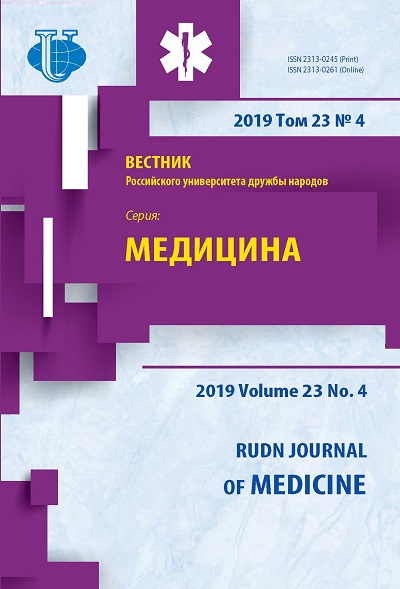Effect of Long-Term Electrical Spinal Cord Stimulation on Expression of Non-Reciprocal Inhibition α-Motoneurons of Human Skeletal Muscles
- Authors: Roshchina L.V.1, Gladchenko D.A.1, Pivovarova E.A.1, Chelnokov A.A.1
-
Affiliations:
- Velikie Luki State Academy of Physical Education and Sports
- Issue: Vol 23, No 4 (2019)
- Pages: 390-396
- Section: BIOLOGY. EXPERIMENTAL PHYSIOLOGY
- URL: https://journals.rudn.ru/medicine/article/view/22799
- DOI: https://doi.org/10.22363/2313-0245-2019-23-4-390-396
Cite item
Full Text
Abstract
It is known, transcutaneous electrical spinal cord stimulation (tESCS) in the T11-T12 level of the thoracic vertebrae increases the power capabilities of the leg agonist muscles. One of the inhibition spinal mechanisms that protects skeletal muscles from excessive force is non-reciprocal inhibition. Taking into account the biological role of non-reciprocal inhibition, the aim of the study was to research the effect of long-term tESCS on expression of non-reciprocal inhibition of soleus muscle α-motorneurons in humans at rest and when holding a weak static force. Materials and methods: the study involved 22 healthy male subjects aged 27 to 35 years. Non-reciprocal inhibition of α-motorneurons was recorded during the 20-minute tESCS in the T11-T12 level of the thoracic vertebrae at rest, in combination with arbitrary muscular effort (5% of MVC) and after its impact. Results: TESCS at rest resulted in the weakening of non-reciprocal inhibition within 20 minutes of exposure and 10 minutes after the end of stimulation. TESCS in combination with arbitrary muscular effort in 5% of the MVC increases the activity of non-reciprocal inhibition for 20 minutes of stimulation and 10 minutes after its end. The proposed physiological mechanisms underlying the effect of long-term tESCS on expression of non-reciprocal inhibition are discussed.
About the authors
L. V. Roshchina
Velikie Luki State Academy of Physical Education and Sports
Author for correspondence.
Email: ljudaroschina@yandex.ru
Velikie Luki, Russian Federation
D. A. Gladchenko
Velikie Luki State Academy of Physical Education and Sports
Email: ljudaroschina@yandex.ru
Velikie Luki, Russian Federation
E. A. Pivovarova
Velikie Luki State Academy of Physical Education and Sports
Email: ljudaroschina@yandex.ru
Velikie Luki, Russian Federation
A. A. Chelnokov
Velikie Luki State Academy of Physical Education and Sports
Email: ljudaroschina@yandex.ru
Velikie Luki, Russian Federation
References
- Fedorov SA, Gorodnichev RM, Chelnokov AA. The effect of prolonged electrical stimulation of the spinal cord on the strength capabilities of skeletal muscles. Ulyanovsk Medical Biological Journal. 2017;1: 123—130. (In Russ.)
- Chelnokov AA, Roshchina LV. Percutaneous electrical stimulation of the spinal cord as a method of increasing the power capabilities of the skeletal muscles of the lower leg. In: Modern methods of organizing the training process, assessing the functional state and recovery of athletes. 2017; 334—336. (In Russ.)
- Pierrot-Deseilligny E, Morin C, Bergego C, Tankov N. Pattern of group I fibre projections from ankle flexor and extensor muscle in man. Exp Brain Res. 1981;42: 337—350.
- Bikmullina RH, Rozental' AN, Pleshchinskij IN. Spinal cord inhibitory systems in the control of interactions of functionally conjugated muscles. Human physiology. 2007;33(1): 119—30.
- Knikou M, Smith AC, Mummidisetty CK. Locomotor training improves reciprocal and nonreciprocal inhibitory control of soleus motoneurons in human spinal cord injury. J Neurophysiol. 2015;113(7): 2447—60.
- Chelnokov AA. Neuronal inhibitory networks of the spinal cord (Scientific review). Nova Info. Ru. 2016;42(3): 24—47; Available from: http://novainfo.ru/article/4893
- Chelnokov AA, Roshchina LV. Percutaneous electrical stimulation of the spinal cord as a method of increasing the power capabilities of the skeletal muscles of the lower leg. In: Modern methods of organizing the training process, assessing the functional state and recovery of athletes. 2017; S. 334—336. (In Russ.)
- Chelnokov AA, Buchackaya IN. Functional features of spinal inhibition of a person with arbitrary motor activity. Theory and practice of physical education. 2015;6: 11—13. (In Russ.)
- Chelnokov AA, Gladchenko DA, Fedorov SA, Gorodnichev RM. Age-related features of spinal inhibition of skeletal muscles in males in the regulation of voluntary movements. Human physiology. 2017;43(1): 35—44. (In Russ.)
- Yamaguchi T, Fujiwara T, Takahara T, Takahashi Y, Mizuno K, Ushiba J, Masakado Y, Liu M. The effects of transcutaneous spinal cord stimulation on spinal re- ciprocal inhibition in healthy persons. Clinical Neurophysiology. 2017; 128(3):115—6.
- Gerasimenko Y, Kozlovskaya I, Edgerton VR. Sensorimotor regulation of movements: novel strategies for the recovery of mobility. Human physiology. 2016;42(1): 106—117.
- Pierrot-Deseilligny E, Morin C, Bergego C, Tankov N. Pattern of group I fibre projections from ankle flexor and extensor muscle in man. Exp Brain Res. 1981;42: 337—50.
- Meunier S. Modulation by corticospinal volleys of presynaptic inhibition la afferents in man. J. Physiol. (Paris). 1999;93(4): 387—94.
- Pyndt HS, Nielsen JB. Modulation of transmission in the corticospinal and group Ia afferent pathways to soleus motoneurons during bicycling. J. Neurophysiol. 2003;89: 304—14.
- Knikou M. The H-reflex as a probe: Pathways and pitfalls. Journal of Neuroscience Methods. 2008;171: 1—12.
- Cash RF, Ziemann U, Murray K, Thickbroom GW. Late cortical disinhibition in human motor cortex: a triple-pulse transcranial magnetic stimulation study. J. Neurophysiol. 2010;103(1): 511—8.
- Pierrot-Deseilligny E, Burke D. The Circuitry of the Human Spinal Cord: Spinal and Corticospinal Mechanisms of Movement. United States: Cambridge University Press; 2012. 606 p.
- Guzmán-López J, Selvi A, Barraza G, Casanova-Molla J, Valls-Solé J. The effects of transcranial magnetic stimulation on vibratory-induced presynaptic inhibition of the soleus H reflex. Exp Brain Res. 2012;220(3—4): 223—30.
- Matsugi A, Mori N, Uehara S, Kamata N, Oku K, Okada Y, Kikuchi Y, Mukai K, Nagano K. Effect of cerebellar transcranial magnetic stimulation on soleus Ia presynaptic and reciprocal inhibition. Neuroreport. 2015;26(3). R.139—43.
- Rossi A, Decchi B. Changes in Ib heteronymous inhibition to soleus motoneurons during cutaneous and muscle nociceptive stimulation in humans. Brain Res. 1997;774: 55—61.
- Barrué-Belou S, Marque P, Duclay J. Supraspinal Control of Recurrent Inhibition during Anisometric Contractions. Med Sci. Sports Exerc. 2019;51(11): 2357—65.
















